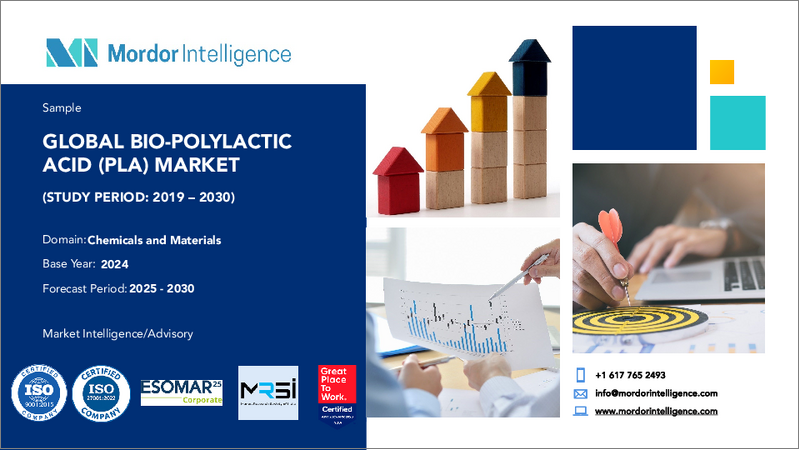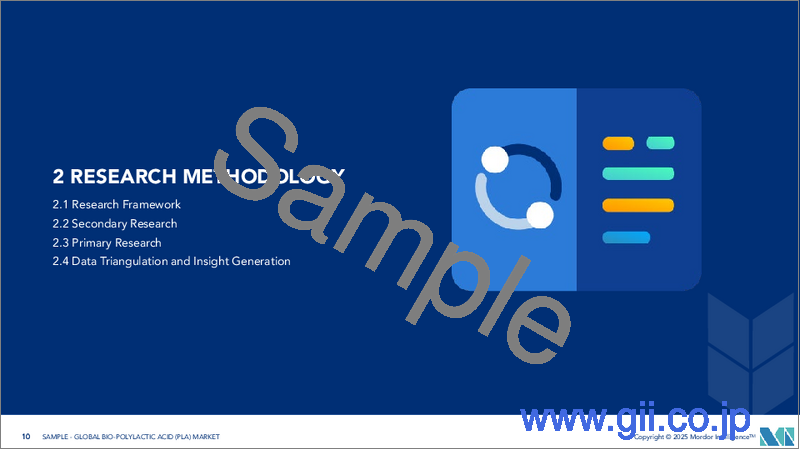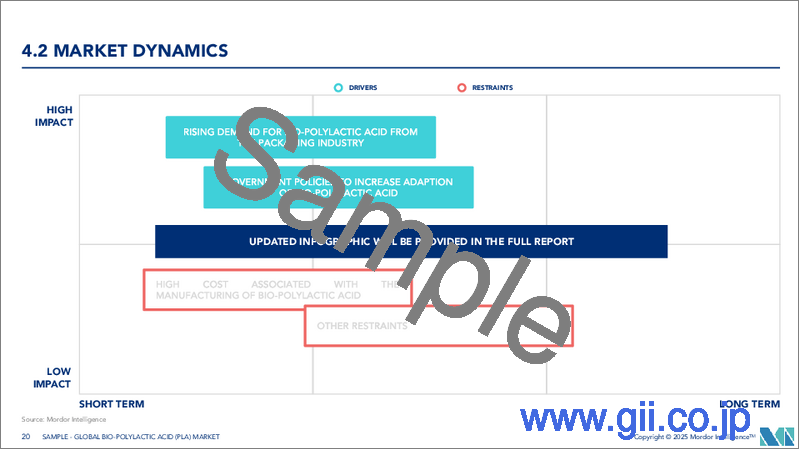|
|
市場調査レポート
商品コード
1686208
バイオポリ乳酸(PLA)-市場シェア分析、産業動向・統計、成長予測(2025年~2030年)Bio-polylactic Acid (PLA) - Market Share Analysis, Industry Trends & Statistics, Growth Forecasts (2025 - 2030) |
||||||
カスタマイズ可能
適宜更新あり
|
|||||||
| バイオポリ乳酸(PLA)-市場シェア分析、産業動向・統計、成長予測(2025年~2030年) |
|
出版日: 2025年03月18日
発行: Mordor Intelligence
ページ情報: 英文 150 Pages
納期: 2~3営業日
|
全表示
- 概要
- 目次
バイオポリ乳酸の市場規模は2025年に259万トンと推計され、2030年には645万トンに達すると予測され、予測期間中(2025~2030年)のCAGRは20%を超えると予測されます。

COVID-19の発生により、世界各地で全国的な操業停止が発生し、製造活動やサプライチェーンの混乱、生産停止、労働力不足が市場に悪影響を与えました。しかし、2021年には状況が回復し始めたため、予測期間中に調査された市場の成長軌道は回復しました。
主なハイライト
- 市場の成長を牽引する主な要因は、バイオプラスチックに対する政府の好意的な政策です。
- 反面、PLAの高コストが市場開拓の妨げになると予想されます。
- 遺伝子組み換えトウモロコシの生産量の増加と、3DプリンティングにおけるバイオPLAの使用量の増加は、将来的にチャンスとなる可能性が高いです。
- アジア太平洋地域が世界市場を独占し、中国や日本などの国々からの消費が最も大きいです。
ポリ乳酸(PLA)市場動向
パッケージングセグメントが市場を独占する見込み
- 包装業界はバイオPLAの最大消費者の一つです。2021年のバイオPLA市場では、パッケージングが収益ベースで68%強を占めています。さらに、パンデミック(世界的大流行)を背景に、衛生や食品の安全性に対する懸念が世界的に優先度を高めています。
- Indian Institute of Packagingによると、インドの包装消費量は過去10年間で200%増加し、1人当たり年間4.3kgから8.6kgに増加しました。とはいえ、中国はこの分野を支配しており、世界最大の包装材料・製品の製造・輸出国です。
- ビタミンのような栄養補助食品や、アレルギー治療薬のような必需品の需要は増加すると予想されます。さらに、環境と気候変動への懸念が、世界各国を生分解性包装材料の選択に駆り立てています。
- バイオPLAは主にスーパーマーケットでの果物や野菜の包装、パンの袋やベーカリーの箱、ボトル、封筒、陳列用カートンの窓、ショッピングバッグやキャリーバッグに使用されています。
- レストランチェーンや食品加工業界では、食品包装に生分解性素材を採用するケースが増えています。また、一部のプラスチックは発ガン性があることが知られているため、食品の安全性についても人々の意識が高まっています。
- ロックダウン後の数字は、消費者の購買嗜好がオフラインからオンラインへとシステム的にシフトしていることを示しています。世界中の顧客がオンラインショッピングに慣れてきており、今後数年間でPLA市場の需要が増加すると予想されます。
中国がアジア太平洋市場を独占する見込み
- 中国はアジア太平洋地域最大の経済大国であり、世界最大級の製造・生産拠点を有しています。
- 同国では、プラスチック禁止と持続可能で生分解性のある包装へのシフトにより、包装産業が著しい成長を遂げています。従って、この期間中、市場を牽引すると予想されます。
- さらに、中国の食品加工産業は成熟に向かっており、緩やかな成長を遂げています。加工・包装された冷凍食品は、特に乳製品、ベビーフード、菓子類を中心に人気が高まっており、食品加工産業の牽引役となっています。
- 中国国家統計局によると、2021年、中国の食品産業は約6,180億元(885億米ドル)の総利益を生み出しました。食品製造業は、総利益に約1,791億元(266億米ドル)を貢献しました。
- 中国は世界最大の繊維生産・輸出国です。工業情報化部(MIIT)によると、中国の繊維産業は2021年に順調に成長し、総利益は前年比25.4%増の2,677億元(382億米ドル)に達しました。
- 2021年の医療費は約7兆2,000億人民元で、国内総生産(GDP)の7.1%を占めています。中国の医療・治療市場は、病院数の増加と医療支援需要の増加により、力強い成長を遂げています。そのため、医療用途の進歩が予測期間中の市場を牽引すると見られています。
- さらに、ZVEI Dia Elektroindustrieによると、中国のエレクトロニクス産業は2021年に約2兆5,000億ユーロ(2兆6,350億米ドル)の規模になり、世界の生産額の50%以上を占め、2022年と2023年にはそれぞれ前年比14%と8%の成長が見込まれています。
そのため、アジア太平洋地域のバイオポリ乳酸市場は、今後数年間は中国が主導する可能性が高いです。
ポリ乳酸(PLA)産業概要
バイオポリ乳酸市場は高度に統合されており、大手4社が生産能力ベースで約86%の市場シェアを占めています。調査対象となった市場の主要企業(順不同)には、NatureWorks LLC、Zhejiang Hisun Biomaterials、Sulzer Ltd、Total Corbion PLA、Futerroなどが含まれます。
その他の特典:
- エクセル形式の市場予測(ME)シート
- 3ヶ月間のアナリスト・サポート
目次
第1章 イントロダクション
- 調査の前提条件
- 調査範囲
第2章 調査手法
第3章 エグゼクティブサマリー
第4章 市場力学
- 促進要因
- バイオプラスチックを促進する有利な政府政策
- その他の促進要因
- 抑制要因
- 高価格とその他のデメリット
- その他の阻害要因
- 産業バリューチェーン分析
- ポーターのファイブフォース分析
- 供給企業の交渉力
- 消費者の交渉力
- 新規参入業者の脅威
- 代替品の脅威
- 競合の程度
第5章 市場セグメンテーション
- 原料
- トウモロコシ
- キャッサバ
- サトウキビとテンサイ
- その他の原料(糖蜜、ジャガイモ、小麦)
- 形態
- 繊維
- フィルム・シート
- コーティング
- その他のフォーム
- エンドユーザー産業
- 包装
- 医療
- エレクトロニクス
- 農業
- 繊維
- その他のエンドユーザー産業(建設、消費財)
- 地域
- アジア太平洋
- 中国
- インド
- 日本
- 韓国
- ASEAN諸国
- その他のアジア太平洋
- 北米
- 米国
- カナダ
- メキシコ
- 欧州
- ドイツ
- 英国
- フランス
- イタリア
- CIS地域
- その他の欧州
- 南米
- ブラジル
- アルゼンチン
- その他の南米地域
- 中東・アフリカ
- サウジアラビア
- 南アフリカ
- その他の中東・アフリカ
- アジア太平洋
第6章 競合情勢
- M&A、合弁事業、提携、協定
- 市場シェア分析
- 主要企業の戦略
- 企業プロファイル
- BASF SE
- BEWiSynbra Group
- Cofco
- Danimer Scientific
- Esun
- Futerro
- Jiangxi Keyuan Bio-Material Co. Ltd
- Musashino Chemical Laboratory Ltd
- NatureWorks LLC
- Polysciences Inc.
- Shanghai Tong Jie Liang Biomaterials Co. Ltd
- Sulzer Ltd
- Weforyou
- Total Corbion PLA
- Zhejiang Hisun Biomaterials Co. Ltd
第7章 市場機会と今後の動向
- 食品包装における新たな用途
- 3DプリントPLAの用途拡大
The Bio-polylactic Acid Market size is estimated at 2.59 million tons in 2025, and is expected to reach 6.45 million tons by 2030, at a CAGR of greater than 20% during the forecast period (2025-2030).

Due to the COVID-19 outbreak, nationwide lockdowns around the globe, disruption in manufacturing activities and supply chains, production halts and labor unavailability negatively impacted the market. However, the conditions started recovering in 2021, thereby restoring the growth trajectory of the market studied during the forecast period.
Key Highlights
- The primary factor driving the market's growth is favorable government policies toward bio-plastics.
- On the flip side, the high cost of PLA is expected to hinder the development of the market studied.
- The growing production of genetically modified corn and the increasing usage of bio-PLA in 3D printing are likely to act as opportunities in the future.
- Asia-Pacific dominated the market worldwide, with the most significant consumption from countries like China and Japan.
Polylactic Acid (PLA) Market Trends
The Packaging Segment is Expected to Dominate the Market
- The packaging industry is one of the largest consumers of bio-PLA. Packaging accounted for a little over 68% of the bio-PLA market in 2021 in terms of revenue. Moreover, concerns about hygiene and food safety in the context of the pandemic have become a higher priority globally.
- As per the Indian Institute of Packaging, the packaging consumption in India has increased by 200% in the past decade, rising from 4.3 to 8.6 kg per person per year. Nonetheless, China dominates the sector and is the largest manufacturer and exporter of packaging materials and products globally.
- The demand is expected to increase for dietary supplements, such as vitamins, and essential supplies, such as allergy medication. Moreover, environmental and climate change concerns are driving countries worldwide to choose biodegradable packaging materials.
- Bio-PLA is primarily used in fruit and vegetable packaging in supermarkets and for bread bags and bakery boxes, bottles, envelopes, display carton windows, and shopping or carrier bags.
- The restaurant chains and food processing industries are increasingly adopting biodegradable materials for food packaging. People are also becoming more aware of how safe food is, since some plastics are known to cause cancer.
- The post-lockdown numbers indicate a systemic shift in consumer purchasing preferences from offline to online. Customers around the world are getting more and more used to shopping online, which is expected to increase demand in the PLA market over the next few years.
China is Expected to Dominate the Market in Asia-Pacific
- China is the largest economy in the Asia-Pacific region and has one of the largest manufacturing and production bases in the world.
- In the country, the packaging industry is witnessing tremendous growth due to the plastic ban and shift toward sustainable and biodegradable packaging. Thus, it is expected to drive the market during the period.
- Furthermore, the Chinese food processing industry is moving toward maturity and experiencing moderate growth. Processed and packaged frozen food products are increasingly popular, especially dairy, baby food, and confectionery products, which is a driver for the food processing industry.
- According to the National Bureau of Statistics of China, in 2021, the food industry in China generated a total profit of about 618 billion yuan (USD 88.5 billion). The food manufacturing industry contributed approximately 179.1 billion yuan (USD 26.6 billion) to the total profits.
- China is the largest textile-producing and exporting country in the world. The textile industry of China grew steadily in 2021, with collective profits of 267.7 billion yuan (USD 38.20 billion), a 25.4 percent increase year-on-year (YoY), according to the Ministry of Industry and Information Technology (MIIT).
- In 2021, the health expenditure was approximately CNY 7.2 trillion, accounting for 7.1% of the country's GDP. The medical and therapeutical market in China has witnessed strong growth due to a growing number of hospitals and the increasing demand for medical assistance. Thus, advancements in medical applications are expected to drive the market during the forecast period.
- Furthermore, according to ZVEI Dia Elektroindustrie, China's electronics industry will be worth approximately EUR 2,500 billion (USD 2635 billion) in 2021, accounting for more than 50% of global production, and is expected to grow at 14% and 8% Y-o-Y in 2022 and 2023, respectively.
So, the bio-polylactic acid market in Asia-Pacific is likely to be led by China over the next few years.
Polylactic Acid (PLA) Industry Overview
The bio-polylactic acid market is highly consolidated, and the four major players have a share of around 86% market in terms of production capacity. The major players of the market studied (not in any particular order) include NatureWorks LLC, Zhejiang Hisun Biomaterials Co. Ltd, Sulzer Ltd, Total Corbion PLA and Futerro, among others.
Additional Benefits:
- The market estimate (ME) sheet in Excel format
- 3 months of analyst support
TABLE OF CONTENTS
1 INTRODUCTION
- 1.1 Study Assumptions
- 1.2 Scope of the Study
2 RESEARCH METHODOLOGY
3 EXECUTIVE SUMMARY
4 MARKET DYNAMICS
- 4.1 Drivers
- 4.1.1 Favorable Government Policies Promoting Bio-plastics
- 4.1.2 Other Drivers
- 4.2 Restraints
- 4.2.1 High Price and Other Disadvantages
- 4.2.2 Other Restraints
- 4.3 Industry Value Chain Analysis
- 4.4 Porter's Five Forces Analysis
- 4.4.1 Bargaining Power of Suppliers
- 4.4.2 Bargaining Power of Consumers
- 4.4.3 Threat of New Entrants
- 4.4.4 Threat of Substitute Products and Services
- 4.4.5 Degree of Competition
5 MARKET SEGMENTATION (Market Size in Volume)
- 5.1 Raw Material
- 5.1.1 Corn
- 5.1.2 Cassava
- 5.1.3 Sugarcane and Sugar Beet
- 5.1.4 Other Raw Materials(molasses, potato, wheat)
- 5.2 Form
- 5.2.1 Fiber
- 5.2.2 Films and Sheets
- 5.2.3 Coatings
- 5.2.4 Other Forms
- 5.3 End-user Industry
- 5.3.1 Packaging
- 5.3.2 Medical
- 5.3.3 Electronics
- 5.3.4 Agriculture
- 5.3.5 Textiles
- 5.3.6 Other End-user Industries(construction, consumer goods)
- 5.4 Geography
- 5.4.1 Asia-Pacific
- 5.4.1.1 China
- 5.4.1.2 India
- 5.4.1.3 Japan
- 5.4.1.4 South Korea
- 5.4.1.5 ASEAN Countries
- 5.4.1.6 Rest of Asia-Pacific
- 5.4.2 North America
- 5.4.2.1 United States
- 5.4.2.2 Canada
- 5.4.2.3 Mexico
- 5.4.3 Europe
- 5.4.3.1 Germany
- 5.4.3.2 United Kingdom
- 5.4.3.3 France
- 5.4.3.4 Italy
- 5.4.3.5 CIS region
- 5.4.3.6 Rest of Europe
- 5.4.4 South America
- 5.4.4.1 Brazil
- 5.4.4.2 Argentina
- 5.4.4.3 Rest of South America
- 5.4.5 Middle-East and Africa
- 5.4.5.1 Saudi Arabia
- 5.4.5.2 South Africa
- 5.4.5.3 Rest of Middle-East and Africa
- 5.4.1 Asia-Pacific
6 COMPETITIVE LANDSCAPE
- 6.1 Mergers and Acquisitions, Joint Ventures, Collaborations, and Agreements
- 6.2 Market Share Analysis
- 6.3 Strategies Adopted by Leading Players
- 6.4 Company Profiles
- 6.4.1 BASF SE
- 6.4.2 BEWiSynbra Group
- 6.4.3 Cofco
- 6.4.4 Danimer Scientific
- 6.4.5 Esun
- 6.4.6 Futerro
- 6.4.7 Jiangxi Keyuan Bio-Material Co. Ltd
- 6.4.8 Musashino Chemical Laboratory Ltd
- 6.4.9 NatureWorks LLC
- 6.4.10 Polysciences Inc.
- 6.4.11 Shanghai Tong Jie Liang Biomaterials Co. Ltd
- 6.4.12 Sulzer Ltd
- 6.4.13 Weforyou
- 6.4.14 Total Corbion PLA
- 6.4.15 Zhejiang Hisun Biomaterials Co. Ltd
7 MARKET OPPORTUNITIES AND FUTURE TRENDS
- 7.1 Emerging Applications in Food Packaging
- 7.2 Growing Applications for 3D-printed PLA





